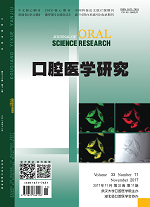|
|
Effect and Functioanl Role of miR-146a in Oral Squamous Cell Carcinoma Tissues and Cell Lines
WANG Li-ping, GUO Xue-qi, YAN Yong-yong, ZHA Jun, CHEN Wei-hong, WEI Yong-xiang, ZHU Xin-xin, GUAN Hong-bing, GE Lin-hu
2017, 33(11):
1204-1208.
DOI: 10.13701/j.cnki.kqyxyj.2017.11.018
Objective: To explore the expression and its functional role of miR-146a in oral squamous cell carcinoma (OSCC) tissues. Methods: RT-PCR was performed to detect the expression level of miR-146a in OSCC tissues and OSCC cell lines. CCK8 assay, transwell assay and wound healing assay were performed to observer cell proliferation, invasion and migration abilities. Results: The expression of miR-146a was significantly higher in OSCC tissues compared to the adjacent tissues (P<0.05), and the expression of miR-146a in OSCC cell lines such as Scc9, Scc25, and Cal27 were substantially higher than the normal oral epithelial cells (HOK) (P<0.05). The proliferation, invasion and migration abilities were substantially enhanced in Scc9 and Cal27 cells transfected with miR-146a mimics (P<0.05). The invasion and migration abilities were substantially decreased in Scc9, Scc25, and Cal27 cells transfected with miR-146a inhibitor (P<0.05), but the proliferation abilities showed no statistically diffierents in Scc9, Scc25, and Cal27 cells transfected with miR-146a inhibitor. Conclusion: miR-146a shows a significant expression in OSCC tissues and cell lines, is correlated with proliferation, invasion and migration of OSCC.
References |
Related Articles |
Metrics
|

